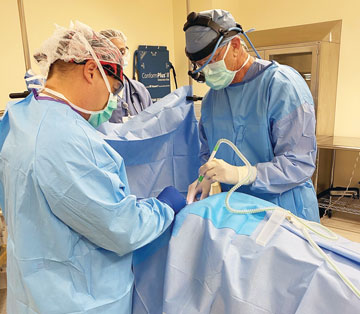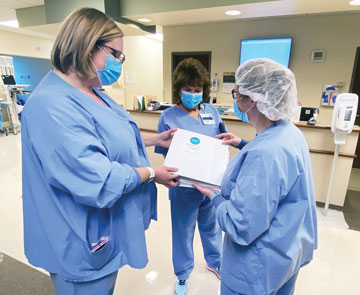Placing products at eye level in grocery stores and retail chains is a strategy used to increase sales. Tabitha Turner, RN, MSN, CNOR, CGRN, the driving force behind the implementation of a surgical smoke evacuation program at Cone Health MedCenter Mebane (N.C.) Surgery Center, cunningly employed this "what you see is what you buy" technique to clear the air in the facility's ORs. Ms. Turner, the facility's assistant director, put packets of research everywhere the eyes of surgeons and staff would fall, including in locker rooms and lounges. She even enticed the surgical team with candy cigarettes to get her point across: Surgical smoke, like cigarette smoke, is dangerous to your health.
In just over a year, Ms. Turner established a smoke evacuation program, an astonishing achievement in so little time. She managed to educate staff and implement the system so quickly because of her determination to find credible research, as well as the guidance offered by AORN's Go Clear Award Program (see "Need Help Going Smoke-free?" below). She systematically followed the steps outlined by the program to institute a strong smoke evacuation protocol, which eventually earned Go Clear's Gold Status.
Ms. Turner's clinical passion drove her to campaign for smoke evacuation, according to Dana Hatchett, RN, BSN, MBA, RNFA, CNOR, director of MedCenter Mebane Surgery Center. After attending a medical conference where she learned about the Go Clear program, Ms. Turner began to dive more deeply into the issue. She spent two months researching the dangers of surgical smoke and presented the information to her leadership to gain support for implementing the Go Clear program. After getting the go ahead, Ms. Turner collected every study and article she could find about surgical smoke and bound the stack of research into a book, which she passed out to staff and surgeons.
Each week, Ms. Turner also posted new information on bulletin boards throughout the center, including a story about an Arizona orthopedic surgeon whose lung cancer was attributed to surgical smoke. It didn't take long to convince staff and surgeons to join the smoke-free movement.
"I spent many months gathering data to support what I was talking about," says Ms. Turner. "It's really important to present surgeons with clinical evidence when asking them to change how they operate."
The research detailing the dangers of surgical plume is irrefutable. Lasers and other electrosurgical devices are used in 90% of surgeries, and about 150 different chemicals are released in the smoke they generate. Surgical masks don't filter out the majority of smoke particles, resulting in hundreds of thousands of healthcare workers being exposed to surgical plume each year. Ms. Turner, who has been working on breast reduction surgeries for about 15 years, says just a gram of tissue — about the size of a jellybean — is equal to six smoked cigarettes, an example she used to hammer home the importance of smoke evacuation.
.svg?sfvrsn=be606e78_3)


.svg?sfvrsn=56b2f850_5)